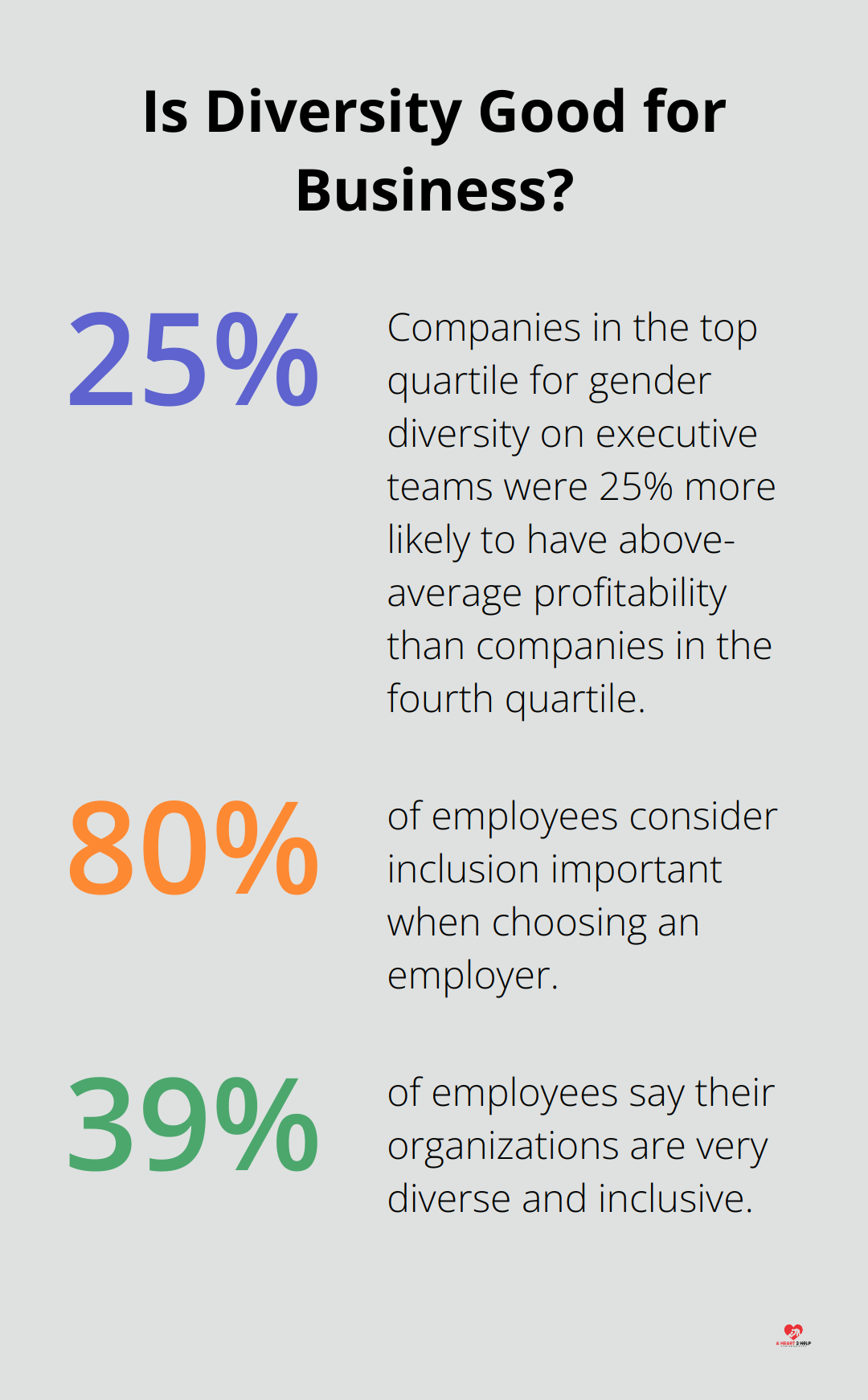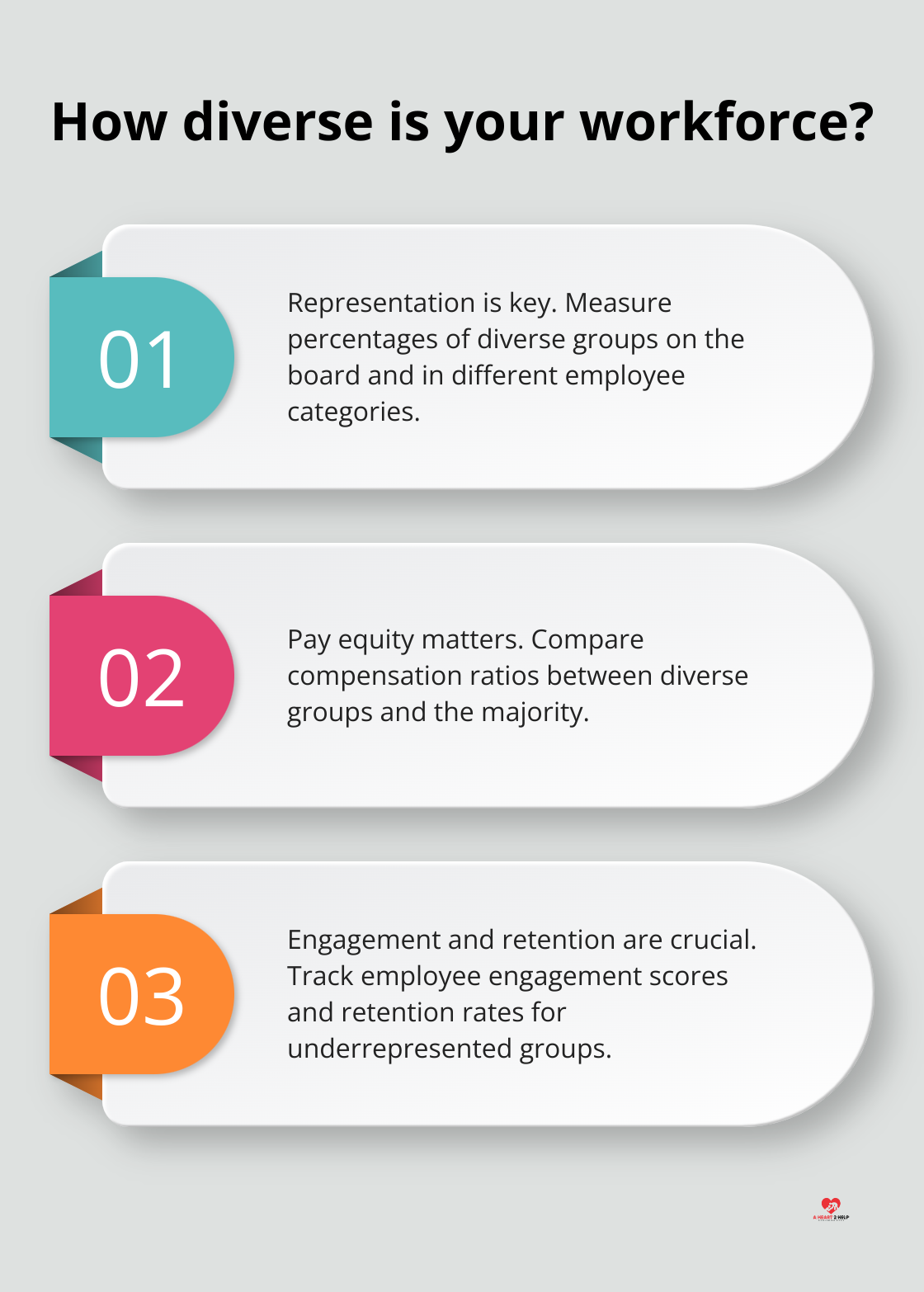Diversity in the workplace is more than a buzzword-it’s a powerful driver of innovation and success. At A Heart 2 Help, we’ve seen firsthand how managing and valuing diversity can transform organizations.
This blog post explores practical strategies for creating inclusive workplaces that harness the full potential of a diverse workforce. We’ll dive into effective management techniques, measurement tools, and future trends to help you build a truly inclusive organization.
Understanding Workplace Diversity: A Multifaceted Approach
Workplace diversity extends far beyond race and gender. It encompasses a broad spectrum of human differences, including age, ethnicity, disability, sexual orientation, religion, and socioeconomic background. This rich tapestry of perspectives and experiences forms the foundation for innovation and business success.
The Multidimensional Nature of Diversity
Diversity in the workplace manifests in various forms:
- Visible Diversity: Includes characteristics like race, gender, age, and physical abilities.
- Invisible Diversity: Encompasses elements such as sexual orientation, education, socioeconomic status, and cultural background.
- Cognitive Diversity: Refers to differences in thinking styles, problem-solving approaches, and decision-making processes.

Understanding these dimensions helps organizations create more inclusive and effective diversity strategies.
The Tangible Benefits of Diverse Teams
Research consistently demonstrates the power of diverse teams. A recent BCG study suggests that increasing the diversity of leadership teams leads to more and better innovation and improved financial performance. This translates to real-world impact: McKinsey reports that companies in the top quartile for gender diversity on executive teams were 25% more likely to have above-average profitability than companies in the fourth quartile.
These statistics underscore the significant financial and innovative advantages that diverse teams bring to organizations.
Navigating Diversity Challenges
While the benefits are clear, managing diversity presents its own set of challenges. Common hurdles include:
- Communication Barriers: Differences in language, cultural norms, and communication styles can lead to misunderstandings.
- Unconscious Bias: Deeply ingrained stereotypes can influence decision-making and interactions.
- Resistance to Change: Some employees may feel threatened by diversity initiatives, leading to pushback.
A 2021 Deloitte survey highlighted this disconnect: 80% of employees consider inclusion important when choosing an employer, yet only 39% say their organizations are very diverse and inclusive.
Proactive Steps for Diversity Management
Organizations must take proactive measures to address these challenges:
- Implement Bias Training: Regular workshops can help employees recognize and mitigate their unconscious biases.
- Create Mentorship Programs: Pairing diverse employees with senior leaders can foster inclusion and career development.
- Establish Clear Diversity Goals: Setting specific, measurable objectives (like Intel’s goal to reach full representation of women and underrepresented minorities in its U.S. workforce by 2020, which they achieved two years early) can drive meaningful progress.
Cultivating an Inclusive Culture
Diversity thrives in an environment where all employees feel valued and heard. This culture of belonging yields tangible results: Employee recognition fosters a sense of belonging that unlocks employee potential.
Practical steps to foster this culture include:
- Encourage Employee Resource Groups: These voluntary, employee-led groups can provide support and advocacy for underrepresented employees.
- Implement Flexible Work Policies: Accommodating diverse needs and lifestyles can increase employee satisfaction and retention.
- Celebrate Diverse Holidays and Cultural Events: This recognition promotes cultural awareness and inclusivity.
- Provide Diversity and Inclusion Training: Ongoing education at all levels reinforces the importance of these values.
As we move forward, it’s clear that a holistic approach to diversity management is essential. The next section will explore specific strategies for effective diversity management, offering actionable insights for leaders committed to building truly inclusive workplaces.
Actionable Strategies for Effective Diversity Management
Revamp Your Hiring Process
Organizations must reassess their recruitment practices to foster diversity. 68% of leaders provided DEI training for managers, according to a Harvard Business Review report. Implement blind resume screening to reduce unconscious bias. Use tools to create job descriptions that appeal to a wider range of candidates.
Develop Tailored Training Programs
Generic diversity training often fails to address specific organizational challenges. Create targeted programs that tackle unique issues within your company. For example, Google’s unconscious bias training reached over 70,000 employees and led to measurable improvements in inclusive behaviors.
Foster Open Dialogue
Companies should create safe spaces for employees to discuss diversity-related issues. Employee resource groups (ERGs) play a vital role in fostering open communication. These groups often lead to policy changes and new initiatives, showcasing the power of employee-driven diversity efforts.
Implement Mentorship and Sponsorship Programs
Mentorship programs significantly impact career advancement for underrepresented groups. Women’s representation in senior manager/director roles rose from 32% in 2015 to 37% in 2024. These initiatives accelerate career growth and create a more inclusive workplace.
Measure and Iterate
Data should drive diversity efforts. Many tech giants publish detailed diversity reports annually, holding themselves accountable and identifying areas for improvement. Set clear, measurable goals and regularly assess your progress to ensure continuous advancement in diversity and inclusion.
Integrate Diversity into Core Business Practices
Diversity shouldn’t remain isolated within HR departments. Integrate it into all aspects of your business. Some companies tie executive compensation to diversity goals, ensuring leadership buy-in and accountability.

The implementation of these strategies creates a more inclusive environment that harnesses the full potential of a diverse workforce. As we move forward, it’s essential to consider how to measure and evaluate the impact of these diversity efforts effectively.
Measuring and Evaluating Diversity Impact
Establishing Key Performance Indicators
Organizations must establish clear, relevant Key Performance Indicators (KPIs) to measure diversity impact effectively. These metrics should align with specific diversity goals and overall business objectives. Common KPIs include:
- Percentage of representation on an organization’s board
- Percentage of representation by employee category
- Pay equality: the ratio of compensation for diverse groups compared to the majority group
- Employee engagement scores by demographic groups
- Retention rates for underrepresented employees
Utilizing Advanced Analytics Tools
Modern HR analytics tools offer powerful insights into diversity data. Platforms like Workday and SAP SuccessFactors provide built-in diversity dashboards that allow real-time tracking of key metrics. These tools can uncover hidden patterns and trends that manual analysis might miss.
Conducting Comprehensive Diversity Audits
Annual diversity audits provide a comprehensive view of an organization’s progress. These audits should examine:
- Hiring practices and candidate pipelines
- Promotion and advancement opportunities
- Pay equity across all levels
- Inclusion in high-visibility projects
- Representation in decision-making processes
Collecting Qualitative Feedback
While quantitative data is important, qualitative feedback provides invaluable context. Employee surveys, focus groups, and exit interviews can reveal insights that numbers alone might miss.
Benchmarking Against Industry Standards
Companies should compare their diversity metrics against industry benchmarks to contextualize their progress. Resources like the Bloomberg Gender-Equality Index or the Human Rights Campaign’s Corporate Equality Index offer standardized comparisons across sectors.

Organizations can create more inclusive environments and reap the benefits of a truly diverse workforce by consistently tracking, analyzing, and acting on diversity data. This data-driven approach can lead to significant improvements in representation and inclusion across all levels of an organization.
Final Thoughts
Managing and valuing diversity is not just a moral imperative; it’s a strategic necessity for organizations to thrive in today’s global marketplace. The data proves that diverse teams drive innovation, improve financial performance, and enhance problem-solving capabilities. Yet, the journey towards inclusivity requires a holistic approach that touches every aspect of an organization.

Organizations must integrate diversity initiatives into core business practices, moving beyond surface-level compliance to embed inclusive values into their culture. This involves setting clear, measurable goals, regularly assessing progress, and iterating based on data-driven insights. As demographics shift and societal expectations evolve, organizations must remain agile in their approach to diversity and inclusion.
At A Heart 2 Help, we understand the power of diverse perspectives in building stronger communities. Our platform connects individuals from all walks of life, fostering a sense of belonging and mutual support. We create a model for how diversity and inclusion can drive positive change on a broader scale (through accessible volunteering and promoting acts of kindness).
